Ground spider
Ground spiders comprise Gnaphosidae, the seventh largest spider family with nearly 2,000 described species in over 100 genera distributed worldwide. There are 105 species known to central Europe,[1] and common genera include Gnaphosa, Drassodes, Micaria, Cesonia, Zelotes and many others. They are closely related to Clubionidae.[2] At present, no ground spiders are known to be seriously venomous to humans.
| Ground spiders | |
|---|---|
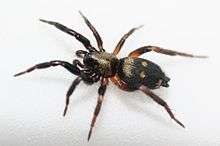 | |
| Callilepis nocturna, a ground spider found in the Palearctic realm | |
| Scientific classification | |
| Kingdom: | Animalia |
| Phylum: | Arthropoda |
| Subphylum: | Chelicerata |
| Class: | Arachnida |
| Order: | Araneae |
| Infraorder: | Araneomorphae |
| Family: | Gnaphosidae Pocock, 1898 |
| Diversity | |
| 158 genera, 3057 species | |
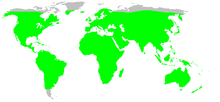 | |
Description
Generally, ground spiders are characterized by having barrel-shaped anterior spinnerets that are one spinneret diameter apart. The main exception to this rule is found in the ant-mimicking genus Micaria. Another characteristic is an indentation in the endites (paired mouthparts anterior and lateral to the labium, or lip). All ground spiders lack a prey-capture web and generally run prey down on the surface. They hunt at night and spend the day in a silken retreat.[2] The genitalia are diverse and are a good model for studying the evolution of genitalia because of their peculiar copulatory mechanism.[3] The thick-walled egg sacs are guarded by the mother until the spiderlings hatch.[2]
Hunting behavior
Ground spiders hunt by active foraging, chasing down and subduing individual prey items. They are adapted to hunting large and potentially dangerous prey, including other spiders, which they subdue by using their silk. When hunting, ground spiders produce thick, gluey silk from their enlarged spinnerets and attempt to use it to entangle their prey in swathing attacks, often applying their webbing to their prey's legs and mouths. By immobilizing potential prey in this manner, ground spiders can subdue proportionally large creatures while reducing risk of injury to themselves from their prey's attempts to fight back.[4]
Genera
As of April 2019, the World Spider Catalog accepts the following genera:[5]
- Allomicythus Ono, 2009 — Vietnam
- Allozelotes Yin & Peng, 1998 — China
- Almafuerte Grismado & Carrión, 2017 — Bolivia, Argentina, Uruguay
- Amazoromus Brescovit & Höfer, 1994 — Brazil
- Amusia Tullgren, 1910 — South Africa
- Anagraphis Simon, 1893 — Africa, Asia, Europe
- Anagrina Berland, 1920 — Niger
- Aneplasa Tucker, 1923 — South Africa, Angola
- Anzacia Dalmas, 1919 — Australia, New Zealand, Papua New Guinea
- Aphantaulax Simon, 1878 — Asia, Africa, Australia, France
- Apodrassodes Vellard, 1924 — South America, Mexico, India
- Apodrassus Chamberlin, 1916 — Peru
- Apopyllus Platnick & Shadab, 1984 — South America, Mexico
- Aracus Thorell, 1887 — Myanmar
- Arauchemus Ott & Brescovit, 2012 — Brazil
- Asemesthes Simon, 1887 — Africa
- Asiabadus Roewer, 1961 — Afghanistan
- Australoechemus Schmidt & Piepho, 1994 — Cape Verde Is.
- Austrodomus Lawrence, 1947 — South Africa
- Benoitodes Platnick, 1993 — St. Helena
- Berinda Roewer, 1928 — Greece, Turkey, Cyprus
- Berlandina Dalmas, 1922 — Asia, Africa, Europe
- Brasilomma Brescovit, Ferreira & Rheims, 2012
- Cabanadrassus Mello-Leitão, 1941 — Argentina
- Callilepis Westring, 1874 — Asia, North America, Europe
- Callipelis Zamani & Marusik, 2017 — Iran
- Camillina Berland, 1919 — Asia, Central America, South America, Africa, North America, Italy, Caribbean
- Canariognapha Wunderlich, 2011 — Canary Is.
- Caudalia Alayón, 1980 — Cuba
- Ceryerda Simon, 1909 — Australia
- Cesonia Simon, 1893 — Greece, Turkey, North America, Central America, Caribbean
- Chatzakia Lissner & Bosmans, 2016 — Spain
- Chileomma Platnick, Shadab & Sorkin, 2005
- Chileuma Platnick, Shadab & Sorkin, 2005
- Chilongius Platnick, Shadab & Sorkin, 2005
- Civizelotes Senglet, 2012 — Asia, Morocco, Europe
- Cladothela Kishida, 1928 — Japan, China, Korea
- Coillina Yin & Peng, 1998 — China
- Coreodrassus Paik, 1984 — Asia
- Cryptodrassus Miller, 1943 — Europe, Asia
- Cryptoerithus Rainbow, 1915 — Australia
- Cubanopyllus Alayón & Platnick, 1993 — Cuba
- Diaphractus Purcell, 1907 — South Africa, Namibia
- Drassodes Westring, 1851 — Africa, South America, Asia, Europe, North America
- Drassodex Murphy, 2007 — Spain, France, Switzerland
- Drassyllus Chamberlin, 1922 — North America, Asia, Europe
- Echemella Strand, 1906 — Congo, Ethiopia
- Echemographis Caporiacco, 1955 — Venezuela
- Echemoides Mello-Leitão, 1938 — South America
- Echemus Simon, 1878 — Sweden, Asia, Australia, Africa, Brazil
- Eilica Keyserling, 1891 — Australia, South America, United States, Central America, Caribbean, Africa, India
- Eleleis Simon, 1893 — South Africa
- Encoptarthria Main, 1954 — Australia
- Epicharitus Rainbow, 1916 — Australia
- Fedotovia Charitonov, 1946 — Mongolia, Iran, Afghanistan
- Gertschosa Platnick & Shadab, 1981 — North America, Panama, Jamaica
- Gnaphosa Latreille, 1804 — Asia, Europe, Africa, North America, Guatemala, Cuba
- Haplodrassus Chamberlin, 1922 — Europe, Asia, North America, Africa
- Herpyllus Hentz, 1832 — Argentina, North America, Asia
- Heser Tuneva, 2004 — Asia, Spain, Africa, North America
- Hitobia Kamura, 1992 — Asia
- Homoeothele Simon, 1908 — Australia
- Hongkongia Song & Zhu, 1998 — Indonesia, China, Hong Kong
- Hypodrassodes Dalmas, 1919 — New Zealand, Australia
- Ibala Fitzpatrick, 2009 — Africa
- Intruda Forster, 1979 — Australia, New Zealand
- Iranotricha Zamani & Marusik, 2018 — Iran
- Kaitawa Forster, 1979 — New Zealand
- Katumbea Cooke, 1964 — Tanzania
- Kishidaia Yaginuma, 1960 — Asia, Italy
- Ladissa Simon, 1907 — Sierra Leone, India, Benin
- Laronius Platnick & Deeleman-Reinhold, 2001 — Thailand, Indonesia
- Lasophorus Chatzaki, 2018 — Greece
- Latonigena Simon, 1893 — South America
- Leptodrassex Murphy, 2007 — Africa, Europe, Asia
- Leptodrassus Simon, 1878 — Europe, Asia, Africa, Mexico
- Leptopilos Levy, 2009 — Greece, Asia, Libya
- Litopyllus Chamberlin, 1922 — United States, Cuba, Mexico
- Lygromma Simon, 1893 — South America, Central America, Caribbean, Mexico
- Lygrommatoides Strand, 1918 — Japan
- Macarophaeus Wunderlich, 2011 —
- Marjanus Chatzaki, 2018
- Matua Forster, 1979 — New Zealand
- Megamyrmaekion Reuss, 1834 — Africa, Asia, Australia
- Micaria Westring, 1851 — Asia, North America, Africa, Europe, Australia
- Microdrassus Dalmas, 1919 — Seychelles
- Microsa Platnick & Shadab, 1977 — Cuba
- Micythus Thorell, 1897 — Thailand, Myanmar, Indonesia
- Minosia Dalmas, 1921 — Africa, Asia, Europe
- Minosiella Dalmas, 1921 — Asia, Africa
- Molycria Simon, 1887 — Australia
- Montebello Hogg, 1914 — Australia
- Moreno Mello-Leitão, 1940 — Argentina
- Myandra Simon, 1887 — Australia
- Namundra Platnick & Bird, 2007 — Namibia, Angola
- Nauhea Forster, 1979 — New Zealand
- Neodrassex Ott, 2012 — Brazil, Argentina
- Neozimiris Simon, 1903 — Panama, North America, South America
- Nodocion Chamberlin, 1922 — North America, India
- Nomindra Platnick & Baehr, 2006 — Australia
- Nomisia Dalmas, 1921 — Asia, Africa, Europe
- Nopyllus Ott, 2014 — Brazil
- Notiodrassus Bryant, 1935 — New Zealand
- Odontodrassus Jézéquel, 1965 — Africa, Asia, Jamaica
- Oltacloea Mello-Leitão, 1940 — Brazil, Argentina
- Orodrassus Chamberlin, 1922 — United States, Canada
- Parabonna Mello-Leitão, 1947 — Brazil
- Paracymbiomma Rodrigues, Cizauskas & Rheims, 2018
- Parasyrisca Schenkel, 1963 — Europe, Asia, North America
- Phaeocedus Simon, 1893 — Asia, Europe
- Plutonodomus Cooke, 1964 — Tanzania
- Poecilochroa Westring, 1874 — Asia, Africa, South America, Europe
- Prodida Dalmas, 1919 — Philippines, Seychelles
- Prodidomus Hentz, 1847 — Asia, Australia, Africa, Cuba, Europe, South America, United States
- Pseudodrassus Caporiacco, 1935 — China, Libya, Turkey
- Pterotricha Kulczyński, 1903 — Africa, Asia, Europe
- Pterotrichina Dalmas, 1921 — Algeria
- Purcelliana Cooke, 1964 — South Africa
- Sanitubius Kamura, 2001 — China, Korea, Japan
- Scopoides Platnick, 1989 — North America, Asia
- Scotocesonia Caporiacco, 1947 — Guyana
- Scotognapha Dalmas, 1920 —
- Scotophaeus Simon, 1893 — Europe, Africa, Asia, South America, New Zealand
- Sergiolus Simon, 1892 — North America, Caribbean, Asia
- Sernokorba Kamura, 1992 — Asia, Europe
- Setaphis Simon, 1893 — Spain, Africa, Asia
- Shaitan Kovblyuk, Kastrygina & Marusik, 2013
- Shiragaia Paik, 1992 — Korea
- Sidydrassus Esyunin & Tuneva, 2002 — Asia
- Smionia Dalmas, 1920 — South Africa
- Sosticus Chamberlin, 1922 — North America, Asia
- Symphanodes Rainbow, 1916 — Australia
- Synaphosus Platnick & Shadab, 1980 — Asia, Africa, North America, Greece
- Talanites Simon, 1893 — Asia, North America, Ukraine
- Talanitoides Levy, 2009 — Israel
- Theuma Simon, 1893 — South Africa, Namibia
- Theumella Strand, 1906 — Ethiopia
- Titus O. Pickard-Cambridge, 1901 — Zimbabwe
- Tivodrassus Chamberlin & Ivie, 1936 — Mexico
- Trachyzelotes Lohmander, 1944 — Europe, Asia, North America, Africa, South America, Samoa
- Trephopoda Tucker, 1923 — South Africa, Namibia
- Trichothyse Tucker, 1923 — South Africa, Namibia
- Tricongius Simon, 1893 — Brazil, Venezuela, Colombia
- Turkozelotes Kovblyuk & Seyyar, 2009 — Greece, Asia
- Urozelotes Mello-Leitão, 1938 — Zambia, Europe, Asia
- Verita Ramírez & Grismado, 2016 — Argentina
- Wesmaldra Platnick & Baehr, 2006 — Australia
- Wydundra Platnick & Baehr, 2006 — Australia, Malaysia
- Xerophaeus Purcell, 1907 — Africa, Yemen
- Xizangia Song, Zhu & Zhang, 2004 — China
- Zelanda Özdikmen, 2009 — New Zealand
- Zelominor Snazell & Murphy, 1997 — Portugal, Spain, Algeria
- Zelotes Gistel, 1848 — Asia, North America, Europe, Africa, South America, Australia, Caribbean
- Zelotibia Russell-Smith & Murphy, 2005 — Africa
- Zelowan Murphy & Russell-Smith, 2010 — Congo, Burundi, Namibia
- Zimirina Dalmas, 1919 — Europe, Africa, Egypt
- Zimiris Simon, 1882 — Asia, Africa, Mexico, Brazil, Germany
- Zimiromus Banks, 1914 — Central America, South America, Caribbean, Mexico
Gallery
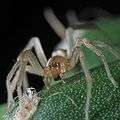 Unidentified species.
Unidentified species.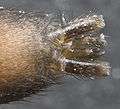 Spinnerets of an Eastern parson spider (Herpyllus ecclesiasticus) in the family Gnaphosidae.
Spinnerets of an Eastern parson spider (Herpyllus ecclesiasticus) in the family Gnaphosidae.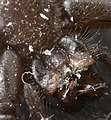 Endites and labium (also fangs and sternum) of an Eastern parson spider.
Endites and labium (also fangs and sternum) of an Eastern parson spider.
See also
References
- Blick; et al. (2004). "Checklist of the spiders of Central Europe. (Arachnida: Araneae)" (PDF). Cite journal requires
|journal=(help) - Nieuwenhuys, Ed (2000). "Spiders of NW-Europe". Retrieved 2007-01-03.
- Azevedo; et al. (2018). "To complicate or to simplify? Phylogenetic tests of complexity trends and genital evolution in ground spiders (Araneae: Dionycha: Gnaphosidae)". Zoological Journal of the Linnean Society. 184 (3): 673–694. doi:10.1093/zoolinnean/zly016.
- Wolff; et al. (2017). "Hunting with sticky tape: functional shift in silk glands of araneophagous ground spiders (Gnaphosidae)". Journal of Experimental Biology. 220 (12): 2250–2259. doi:10.1242/jeb.154682. PMID 28615490.
- "Family: Gnaphosidae Pocock, 1898". World Spider Catalog. Natural History Museum Bern. Retrieved 2019-04-22.
- Platnick, N.I. & Shadab, M.U. (1983): A revision of the American spiders of the genus Zelotes (Araneae, Gnaphosidae). Bulletin of the AMNH 174: 99-191. PDF (29Mb) - Abstract
External links
| Wikispecies has information related to Gnaphosidae |
| Wikimedia Commons has media related to Gnaphosidae. |